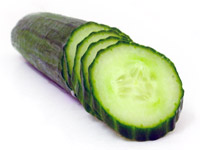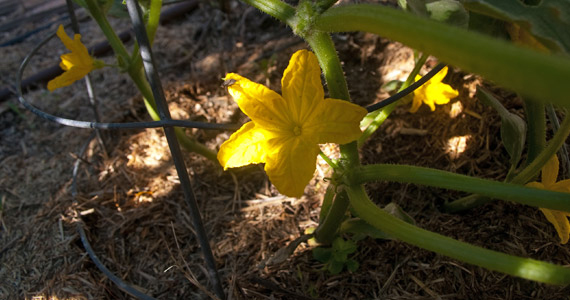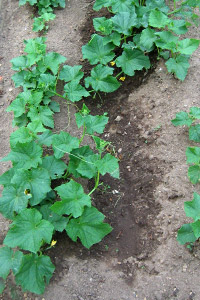Grow cucumber


Grow your own cucumbers
Cucumbers can be grown outdoors in spring and summer. If you have a grow tent, you can enjoy your own cucumbers all year round. With CANNA's substrates and plant food you ensure the ideal conditions.
About cucumbers
The cucumber plant, belonging to the species Cucumis Sativus, is a fast-growing climber that produces many fruits. You can harvest dozens of cucumbers from one stem. Delicious as a snack or side dish, with a salad or on a sandwich. And it also works great as a face mask. If you start growing cucumbers yourself, you will see that you will use this fruit even more. And that is only healthy!
Grow mini cucumbers
The mini cucumber variety Picowell (lat. Cucumis sativus) gives a lot of cucumbers. At about ten to fifteen centimetres, it is a lot smaller and sturdier than its big brother. It is a very fast growing climber and therefore requires regular maintenance and a home grower with a green thumb. You can grow this variety outdoors, as long as it is not too cold at night. The plants certainly cannot withstand night frost, so don't put them outside before the end of April. This plant also feels good inside a grow tent - this variety is often used in greenhouses for a reason. The time between sowing and the ripening of the first fruit is about five weeks. About 2 weeks after that you can harvest mini cucumbers for a month.

Sowing and sprouting cucumbers
Use a good sowing soil for sowing cucumbers. You can make these by mixing three parts of potting soil with one part of sand. CANNA Terra Seedmix is a ready-to-use and ready seed soil, tailored to vegetables and completely pure. Use a seed tray that you can cover. Fill this container with sowing soil. Moisten the soil and let it acclimatize to a temperature of about 20°C.
Spread the cucumber seed over the soil and fill the container with a maximum of half a centimeter of seed soil or Terra Seedmix. Cover the seed tray with a plastic lid or glass plate to maintain temperature and prevent drying out. During the day you let the soil air out by leaving the cover plate ajar (for example, place a stick under the plate).
Sowing can possibly be done in the grow tent. Make sure that the light does not shine too brightly on the young plants: they can burn and dry out.
Transfer the seedlings
Transferring the small plants from the seed tray to a larger pot can be done when the first true pair of leaves appears. This so-called transplanting can be done a good week after sowing. Preferably place the seedlings in three to six liter pots. This gives the plants a moisture buffer that is large enough for the entire cultivation period.
For the best result, use a high-quality and specialist substrate such as CANNA Terra Professional, Terra Professional Plus or Coco. For organic cultivation, use the certified BIOCANNA Bio Terra Plus potting soil.
Should I Pollinate Cucumbers?
Unlike tomatoes, bell peppers and peppers, the Picowell cucumber variety also produces fruit without pollination. Bumblebees and bees like the nectar, but it is not necessary for the plant that they come by. However, the fruits do not contain seeds.
Lead and thieves
The cucumber plant is a climbing plant and the stem must therefore be guided regularly along a stick or wire for sufficient support. The offshoots in the axils of the leaves can be removed as much as possible (we call this thieves).

Fertilizing cucumber plants
Cucumbers thrive in airy, friable soil. If you mix a few centimeters of organic material into the soil before planting, this will contribute to good growth. Cucumber plants need a lot of nutrition. So make sure you feed the soil well with rich compost or manure. After the tendrils have sprouted, the first flowers appear. At that moment you have to add compost or (organic) manure.
If the leaves turn yellow, your plant needs more nitrogen. Let the plants grow with a spacing of 15 to 20 centimeters. Knolls with one or two seedlings should be spaced about three feet apart, and the rows spaced about five feet apart.
Cucumbers are always thirsty!
Keep your cucumber plants well moist, especially around the time the plant is flowering and bearing fruit. Water stress during this period of rapid growth increases the amount of bitter flavor in your fruits.
Cucumbers are vigorous growers. They need 1.5 to 3 inches of water per week, depending on the weather and the properties of the soil they are in.
Always keep the soil slightly moist. Give them plenty of water once or twice a week. If you're gardening in sandy soil, you do it even more often.
Temperature, light and humidity
The cucumber is originally a tropical fruit. The plant grows best at a temperature of 25°C during the day and 20°C at night. The plants need 14 hours of light per day for proper development. The cucumber grows best at a relative humidity (RH) of 70%. In a grow tent, the RH is usually lower (40 to 50%). A small layer of water on the ground or a mister can help to increase the humidity. Make sure the night temperature in the grow tent is at least 16°C.
Diseases and plagues
Mourning midges (peat flies) are often present in the substrate, but these are harmless to the plant and will disappear on their own. Some plants can suffer from whiteflies, aphids and a number of other pests and diseases. You can prevent and treat these without poison with CANNACURE. For more information read the Pests and Diseases Guide .
4 Growing tips for growing cucumber
- A cucumber is a creeper. Use a trellis to grow your cucumber plant against. This way you can improve the ratio between leaf and fruit. The yield of perfect, tasty fruits increases. In addition, it will be easier for you to pick them.
- To increase your yield even further, provide a mulch layer of organic material under the cucumbers.
- If you repeat planting new cucumbers a month later, you can extend your harvest season. Also try planting different varieties. And if it is super hot in the summer, grow your second planting at the beginning of autumn. Make sure you cover the rows well.
- You may want to grow different types of plants one after the other, this is called crop rotation. Then it is useful to know that cucumbers often do well in the ground after cabbage crops have grown.


